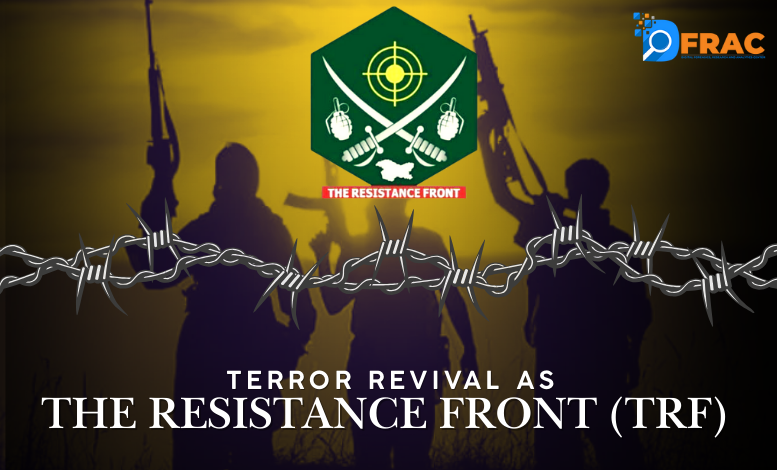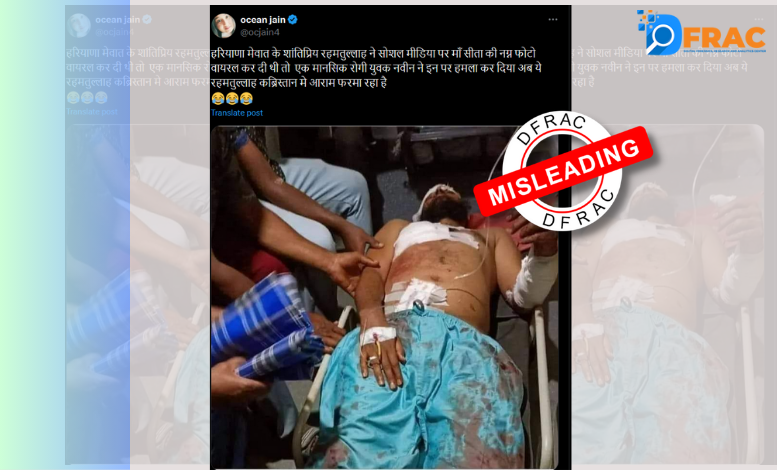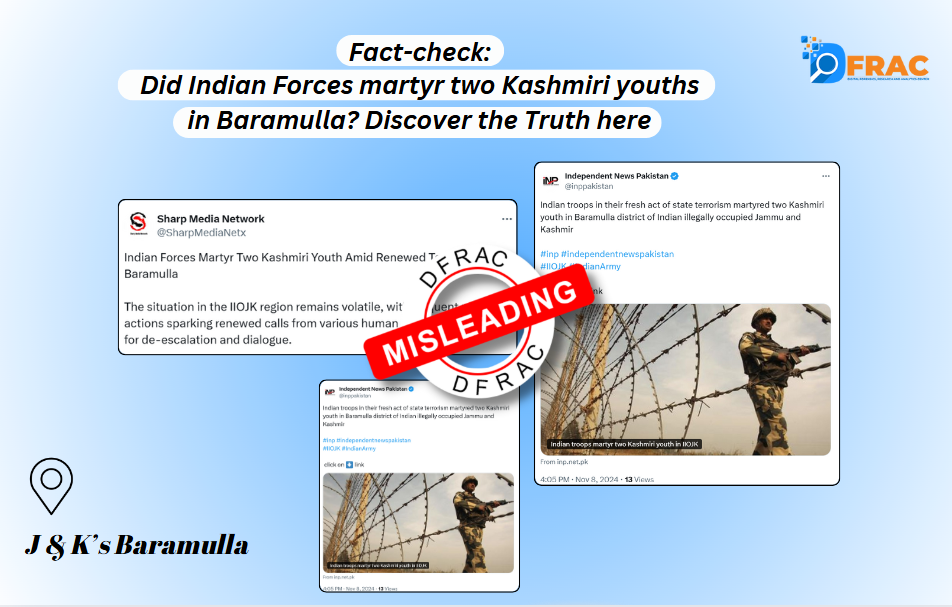Executive Summary
On October 20, 2024, Kashmir’s Ganderbal district witnessed a brutal attack by The Resistance Front (TRF), claiming the lives of six construction workers and a doctor, underlining TRF’s evolving tactics in Kashmir. The TRF—a group backed by Pakistan’s intelligence agency, the ISI—immediately claimed responsibility, marking yet another event in its mission to destabilize the region and propagate anti-India sentiment under the guise of local resistance. Created as a proxy to conceal Pakistan’s direct involvement, TRF targets Indian security forces and civilians, while using social media to recruit Kashmiri youth and amplify its propaganda.
Since its establishment following the 2019 Pulwama attack, TRF has served as a front for Lashkar-e-Taiba (LeT), but under the cover of a supposed “indigenous” resistance movement. Pakistani handlers specifically chose the name “The Resistance Front” to present a secular front and evade the jihadist label, with the goal of garnering international sympathy and support from global activists. TRF’s presence on platforms like Telegram, WhatsApp, and Twitter enables it to evade restrictions, coordinate attacks, and sustain its recruitment network. This report examines TRF’s origins, online influence, operational tactics, and its founders’ deep terror affiliations, highlighting the methods through which Pakistan continues its covert campaign in Kashmir via TRF.
What is TRF?
The Resistance Front (TRF) is a militant group active in the Kashmir Valley, formed under the patronage of Pakistan’s Inter-Services Intelligence (ISI). Established shortly after the Pulwama attack in 2019, TRF functions as a front for established militant organizations like Lashkar-e-Taiba (LeT) and Jaish-e-Mohammed (JeM), avoiding international scrutiny by posing as a “local” group. This façade was specifically crafted by Pakistan to downplay its involvement in Kashmir’s insurgency while mobilizing Kashmiri youth towards militancy.
TRF’s formation was not only to sustain militancy but also to advance ISI’s larger objectives, portraying Kashmir’s unrest as a “local resistance movement.” The name “The Resistance Front” was carefully selected for its secular tone, designed to attract international sympathy by masking the group’s jihadist connections. This strategy allows TRF to operate as a proxy for Pakistan’s anti-India agenda, reducing global pressure on Pakistan while continuing to destabilize the Kashmir Valley.

Social Media Presence and Amplification
To promote its violent ideology and recruit Kashmiri youth, #TRF heavily relies on platforms with limited content moderation, such as Telegram, Tam Tam, and Discord. Messaging apps like Telegram and WhatsApp have been essential tools for TRF’s propaganda campaigns. TRF’s original Telegram channel, deleted after the May 3, 2020 Handwara attack, has since re-emerged under various names, including “Resistance Media” and “Kashmir Resistance 1.” After the October 20 attacks, a new public Telegram group called “KResistance” appeared, eventually leading to another group, “KF Files.”


Alongside Telegram, TRF is now spreading its messaging through newly-created Twitter accounts. Posts include immediate updates following their attacks, such as the October 28 attack in Akhnoor, Jammu. These Twitter accounts, typically created less than two months prior, help expand TRF’s influence across platforms, amplifying their outreach and threat announcements through coordinated online propaganda.
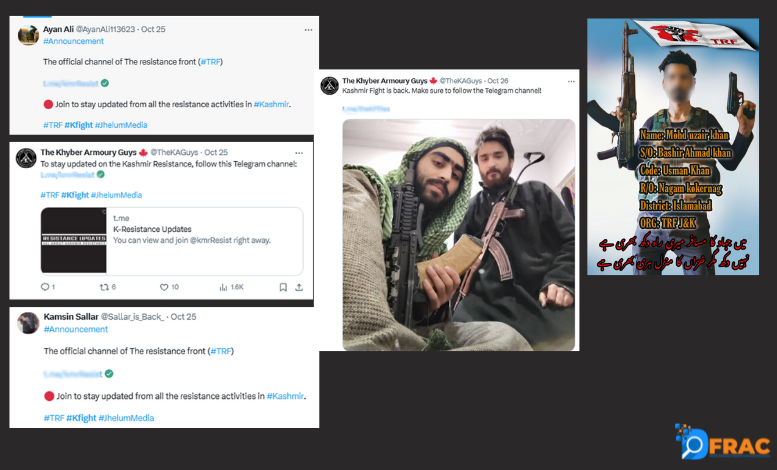
Currently, the account Ayan Ali (@AyanAli113623), which shared the telegram links of TRF has changed its Username and called itself in a girl’s name Shaheen (@Ahma113625). Continuing its similar posts as Ayan Ali in support of TRF.
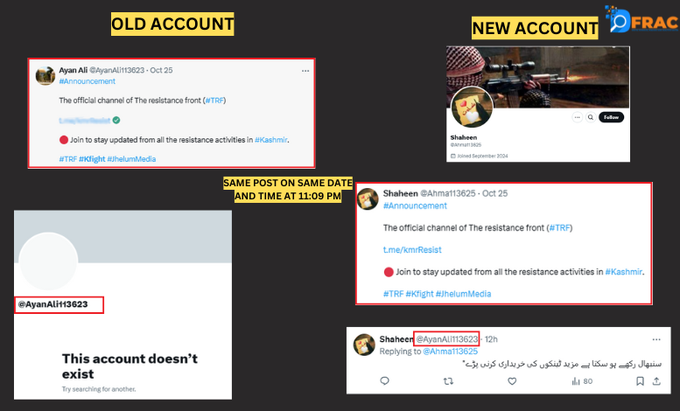
TRF has also been active on Facebook, using an account called “The Joint Kashmir Front” to propagate anti-India sentiments and recruit youth. On WhatsApp, TRF’s influence reaches supporters of other terrorist organizations like Ansar-Ghazwat Al-Hind (AGH), an Al-Qaeda affiliate. In one WhatsApp exchange, a TRF supporter with the alias “Cobra” described TRF as an umbrella group unifying all Kashmir-based terror factions, including groups typically aligned with AGH and the Islamic State Jammu and Kashmir (ISJK). This coordination illustrates TRF’s growing network within the region.


Pakistani Involvement
A report by Kashmir Open Source Intelligence in 2020 provided clear links between TRF and Pakistan. Two of the five militants killed in a Kupwara gunfight were Kashmiris who had travelled to Pakistan legally as civilians, only to later infiltrate back as militants. Such a movement would not have been possible without the support of Pakistani authorities. An Indian Express Report from May 2020 informed that in 2018, the J&K Police recommended that any youth wishing to visit Pakistan should undergo police clearance due to a trend where young Kashmiris, sent on valid visas, would be trained by Pakistan-based terror groups and then infiltrated back via the LoC.

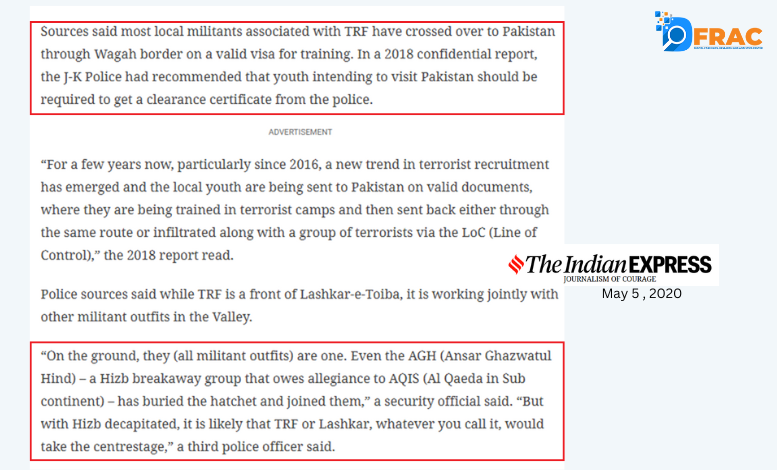
Foundation and Modus Operandi
TRF began to show signs of its operational strength in 2019, when a network of over-ground workers (OGWs) was dismantled in Sopore & Kupwara. 4 TRF-linked operatives were arrested during the crackdown. Investigations revealed that these individuals worked under Pakistan-based handlers known by aliases like “Andrew Jones” on Telegram and “Khan Bilal” on WhatsApp, who directed recruitment and operational activities for TRF in Kashmir. They used covert online communication to execute their activities in the valley, particularly in North Kashmir, drawing new recruits to strengthen TRF’s operational network.
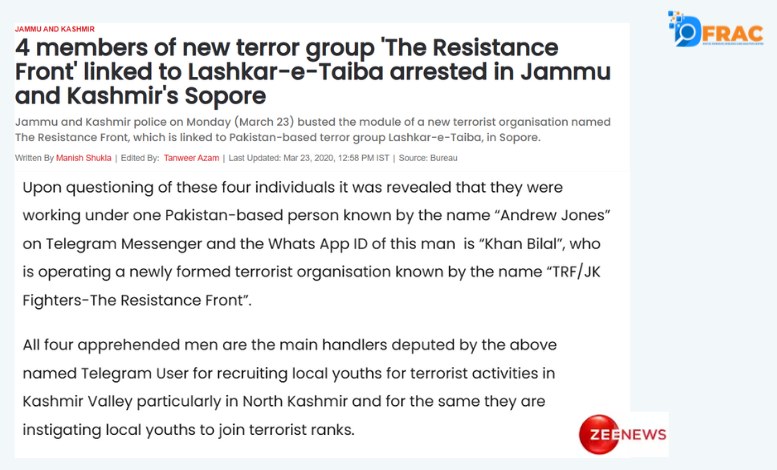

Leadership of TRF: Sheikh Sajjad Gul
TRF’s foundation traces back to key figures with longstanding militant histories in the region. Sheikh Sajjad Gul, the founder, previously orchestrated the murder of prominent Kashmiri journalist Shujaat Bukhari. Arrested in 2002 with a cache of explosives, Sajjad later acquired a fake passport and moved to Pakistan in 2017, where he further consolidated TRF’s structure. Known for his deadly skills and deep ties with LeT, Sajjad Gul was pivotal in transforming TRF into a formidable militant network.


Co-Founder Muhammad Abbas Sheikh
Muhammad Abbas Sheikh, TRF’s co-founder, had a long record of militancy dating back to 2004. Despite several arrests, he resumed militant activities each time, ultimately becoming a major figure within TRF. Killed in a police encounter in 2021, Abbas’s militant influence extended through his family, with multiple members involved in similar activities. His death paved the way for Basid Dar to take up his operational responsibilities within TRF.
Basid Sheikh Dar, a militant from Redwani Payeen, Kulgam in South Kashmir, was a known figure in the Resistance Front (TRF). Following the death of Abbas Sheikh in an August 2021 encounter with Srinagar Police, Basid was appointed Chief Operational Commander by TRF’s supreme commander, Sheikh Sajjad Gul. Dar was reportedly the orchestrator behind multiple targeted civilian killings in October. His activities were halted when Indian Security Forces killed him in an encounter in Kulgam on May 7, 2024.
Ahmed Khalid: TRF’s Propaganda Spokesperson Ahmed Khalid serves as the spokesperson for TRF and has a long-standing association with Sheikh Sajjad Gul, especially since his arrest for his role in the 2018 assassination of journalist Shujaat Bukhari. Khalid was responsible for coordinating hate and intimidation campaigns against Bukhari, using platforms like “http://Kashmirfight.wordpress.com,” his Facebook account “Kadwa Sach Kashmir,” and his Twitter handle “Ahmad Khalid@313 .” In an with a Turkish media outlet, Khalid disclosed that TRF operates under the United Jihad Council (UJC), an ISI-managed coalition overseeing various militant groups in Kashmir. The UJC, led by Syed Salahuddin (designated as a global terrorist by the U.S. State Department), coordinates operations of banned terror outfits like Hizbul Mujahideen, advocating for Kashmir’s separation under Pakistan’s guidance.

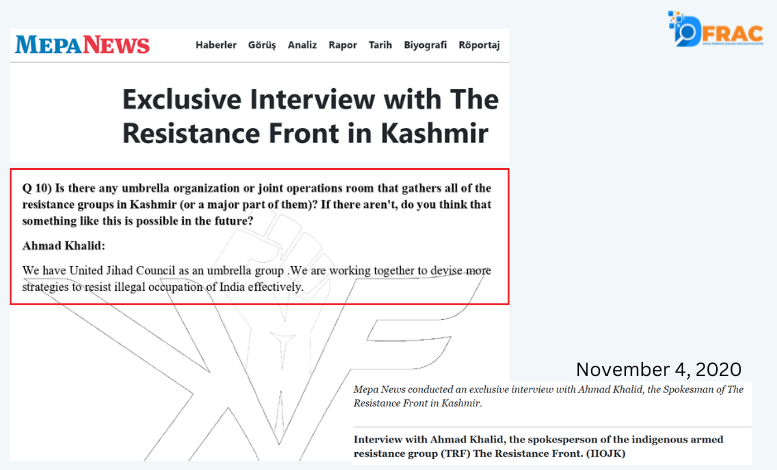
Conclusion
In June 2012 in an interview, Hizb-ul-Mujahideen chief Syed Salahuddin accepted that Pakistan had been backing Hizbul Mujahideen for fighting in Kashmir.[5] He had threatened to start attacking Pakistan if the latter stopped backing the separatist militants in Jammu and Kashmir. TRF’s founders and key figures are deeply linked to prior terror attacks in Kashmir, trained in Pakistan under LeT operatives, and operate under the umbrella of the United Jihad Council. Yet, Pakistan insists on labelling TRF as an “indigenous resistance group” with “no ties to Pakistan.”

The irony couldn’t be clearer.


